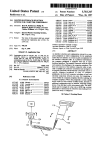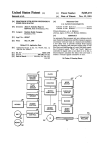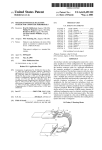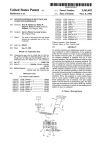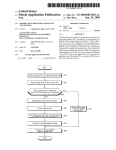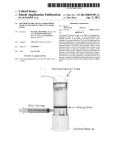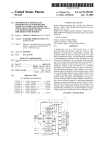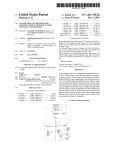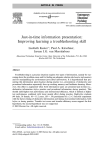Download Multiple-interface selection system for computer peripherals
Transcript
. US005347113A Ulllt?d States Patent [19] [11] Patent Number: Reddersen et al. [45] [54] MULTIPLE-INTERFACE SELECTION SYSTEM FOR COMPUTER PERIPHERALS 4,954,101 5,040,993 9/1990 Nelson .............................. .. 439/502 8/1991 Krug et a1. ..... .. 439/620 5,181,858 l/l993 [75] Inventors: Brad R. Reddersen; Phllhp W. Shepard; Rockie D. Moch, all of _ _ Date of Patent: 5,347,113 Sep. 13, 1994 Matz et a1. ........................ .. 439/489 5,214,268 5/1993 Doing ................................ .. 235/462 5,222,164 6/1993 Bass, Sr. et a1. 439/488 Eugene, Oreg, 5,250,792 10/1993 Swartz et al. ..................... .. 235/472 [73] Assignee: Spectra-Physics Scanning Systems, Inc., Eugene, Oreg. [21] Appl. No.: 39,606 Primary Examiner-John Shepperd Attorney, Agent, or Firm-Lyon & Lyon [22] Filed; An interface selection and con?guration system for a Mar. 25, 1993 [57] ABSTRACT computer peripheral in which con?guration for the Related US, Application Data [63] continuatiomimpm ofsen No_ 34,189, Man 22, 1993’ accomplished by ‘the interface connector cable. In a which is a continuation of Ser. No. 788,267, Nov. 4, 1991, abandoned, Preferred embodlment’ the computer Penpheral 1s equipped with one or more hardware interfaces. The interface connector cable has a ?rst end connector for attaching to the computer peripheral_ The ?rst end 5 ' ' [58] peripheral and/or the host interface is at least in part ................................... ' """""""""""""""""""" " 439/489’_ 439/626 Field of Search """"" multiple pin connector constructed and arranged to be /375 43g 465, 1741/268’ properly physically and electrically connectable only to _ [56] connector of the interface connector cable is typically a 439/488 489 ’491 620 ’ ’ ’ a speci?c computer peripheral or class of computer References Clted peripherals, the ?rst end connector including at least U.S, PATENT DOCUMENTS 4 579 407 M1986 Shimada 439/620 4:678:288 7/1987 Lonsdale """""" " 350/432 one electrical connection between two pins for com pleting a circuit within the computer peripheral thereby enabling the computer peripheral. Where the peripheral 4,694,182 is a data reading device Such as a laser scanner, alternate 9/1987 Howard ............................ .. 250/566 4,699,447 10/1987 Howard . 4,820,l93 4/1989 Noorily ............................. .. 439/488 or additional con?guration may be provided by read ing, with data reading device, a label on the intercon 432??? 3/1939 5319“ et nect cable. The label, which may for example be a bar ---- -~ -- 16g 226837; 92383 B13323 ' 23 51422 code, contains information or instructions by which the 4:902:244 2/1990 Endo et 439/439 data reading device (and/or the host) is con?gured. 4,915,639 4/1990 4,941,845 7/1990 Eppley et a1. ..................... .. 439/505 Cohn et a1. . . .. . . . .. 439/488 16 Claims, 5 Drawing Sheets US. Patent Sep. 13, 1994 Sheet 1 of s ' 5,347,113 US. Patent Sep. 13, 1994 Sheet 2 of 5 5,347,113 21 22 [12.3 42 32 [12.1 US. Patent Sep. 13, 1994 Sheet 3 of 5 5,347,113 US. Patent Sep. 13, 1994 Sheet 4 of 5 5,347,113 US. Patent Sep. 13, 1994 Sheet 5 of 5 5,347,113 1 5,347,113 SUMMARY OF THE INVENTION MULTIPLE-INTERFACE SELECTION SYSTEM FOR COMPUTER PERIPHERALS The present invention relates to an interface selection system for a computer peripheral in which con?gura tion for the peripheral and/or its host is at least in part accomplished through the interface connector cable. In RELATED APPLICATIONS This application is a continuation-in-part of applica a preferred embodiment, the computer peripheral is tion Ser. No. 08/034,189 ?led Mar. 22, 1993, which is a continuation of application Ser. No. 07/788,267 ?led Nov. 4, 1991 now abandoned. 2 equipped with one or more hardware interfaces. The interface connector cable has a ?rst end connector for 10 attaching to the computer peripheral. The ?rst end connector of the interface connector cable is typically a BACKGROUND OF THE INVENTION multiple contact connector (such as pin or edge connec The ?eld of the present invention relates to intercon tor) constructed and arranged to be properly physically nection systems for computers and computer peripher and electrically connectable only to a speci?c computer peripheral (or class of computer peripherals), and a speci?c host interface the cable connector including at als or more speci?cally, methods and devices for select~ ing proper interface between a computer peripheral and its host interface such as may include a computer. Host computers need to be interconnected to a wide least one electrical connection between two contacts for completing a circuit within the computer peripheral variety of peripheral devices including printers, scan thereby enabling the computer peripheral. ners, monitors, and controllers among others. When the 20 In another preferred embodiment where the periph host computer is being connected to a certain type of eral is a data reading device such as a laser scanner, peripheral, for example a handheld laser scanner, the alternate or additional con?guration may be provided computer typically has a single input/output connector by reading, with the data reading device, a label on the to which the scanner may be connected by an intercon interconnect cable. The label, which may for example nect cable. It is frequently desirable that a particular 25 be a bar code, contains information or instructions by handheld scanner be usable with a variety of different which the data reading device (and/or the host) is con ?gured. host computers. Conversely, it is also desirable that the host computer be able to support a variety of different BRIEF DESCRIPTION OF THE DRAWINGS handheld scanners. FIG. 1 is a diagrammatic view of a handheld laser scanner attached to a host computer according to the Heretofore there have been several systems for achieving proper con?guration between the host com puter and the peripheral. In a typical system, a particu lar peripheral is con?gured to work with a particular host computer, that is, the peripheral has contained a single dedicated interface. Similarly, the host computer present invention; FIG. 2 is a diagrammatic view of an interface connec tor system according to the present invention; 35 connector as in FIG. 2; ent host computer, it was necessary to replace the inter FIG. 5 is a diagrammatic view of an alternate periph face software and hardware in the peripheral. eral con?guration system; The host computer may include a software selection FIG. 6 is an end view of an end connector in FIG. 5 program in which the user inputs information identify taken along line 6-—6; ing the particular peripheral enabling the system to FIG. 7 is an end view of an end connector in FIG. 5 have proper operation. Such an operation requires the user to correctly input information into the host com puter identifying the particular peripheral. Alternately, taken along line 7—-7; 45 FIG. 5; of the peripheral which informs the computer of the host of the type of peripheral and software provides the desired con?guration. Many of these systems still re quire correct interface hardware. FIG. 8 is a connector schematic illustrating an exam ple cable connection scheme for the cable connector of means are provided for scanning a code on the outside type of peripheral. Some peripherals actually include identifying signals which again inform the particular FIG. 3 is a detailed diagrammatic view of a printed circuit board of FIG. 2; FIG. 4 is a detailed diagrammatic view of an edge was con?gured to accept only a particular type of pe ripheral. Any time the peripheral was moved to a differ FIG. 9 is a diagrammatic view of an alternate periph eral con?guration system; 50 ' FIG. 10 is an end view of an end connector in FIG. 9 taken along line 10—10; FIG. 11 is an end view of an end connector in FIG. 9 taken along line 11-11; In another con?guration technique, the peripheral FIG. 12 is a connector schematic illustrating an exam includes interface hardware for more than one host 55 ple cable connection scheme for the cable connector of computer. When con?guring, the printed circuit board of the peripheral requires certain hardware con?gura FIG. 9; tion in order to be correctly linked to a host computer. bodiment; FIG. 13 illustrates an alternate cable connection em Such hardware con?guration may be effectuated by FIG. 14 illustrates a cable scanning code operation; manually actuable external switches or by internal 60 and switches or “jumpers” within the printed circuit board FIG. 15 illustrates various peripheral/host pairs. (and/or within the host computer) which activate or DESCRIPTION OF THE PREFERRED deactivate certain components. Such an operation typi EMBODIMENTS cally requires the expertise of an electronics technician or skilled user and is not a desirable ?eld operation to be 65 The preferred embodiments will now be described performed by the typical user. It is desirable to have an with reference to the drawings. inexpensive and easy to use interconnection system In FIG. 1, an example computer peripheral is illus which can be effectively used by the average user. trated as a handheld laser scanner 10 used for scanning 3 5,347,113 a bar code 11. The scanner 10 is operably connected to a host interface (diagrammatically illustrated as a com puter 15) via an interconnect cable 38. The interconnect cable 38. includes an end plug or edge connector 30 4 contacts #2, #4 and #6 are used for communication. When the interconnect cable 38 is plugged into the printed circuit board 20, edge contacts #1 and #3 of the edge connector 21 are thereby electrically connected, which connects to a mating connector 21 on the end of 5 and edge contacts #5 and #7 are also electrically con a printed circuit board 20 within the scanner 10. The nected. By so electrically connecting these electrical interconnect cable 38 provides a communication link between the host computer 15 and the laser scanner 10 and may also provide power to the scanner 10. Referring to FIG. 2, the interconnect cable 38 has a ?rst end connector 30 which plugs into the scanner 10 attaching to the edge connector 21 of the circuit board 20, and a second end connector 40 which plugs into the host computer 15 attaching to the edge connector 18. The ?rst end connector 30 includes tabs 34, 36 which slide into and mate with corresponding slots 24, 26 in the body of the handle of the scanner 10. Different types of scanners may be equipped with different positions of the slots 24, 26. Only an end connector 30 having the correct con?guration of tabs 34, 36 will be correctly physically connectable to the scanner 10. An intercon nect cable 38 without the correct tab con?guration cannot physically be plugged into the laser scanner 10. Similarly on the host computer side of the intercon nect cable 38, the second end connector 40 is equipped with a tab 44 which mates with a corresponding slot 17 at the mating edge connector 18 of the host computer 15. Only an end connector 40 having the correct con?g uration of the tab 44 will be correctly physically con nectable to the host computer 15. An interconnect cable 38 without the correct tab con?guration cannot physi callybe plugged into the host computer 10. contacts, certain circuits within the circuit board 20 become electrically connected resulting in a desired con?guration. The scanner 10 becomes con?gured to accept a particular host computer 15. The user has con?gured the scanner merely by plugging in the cor rect interconnect cable 38. A similar con?guration selection system may alter nately or in combination be applied to the host com puter connection side. The edge connector 40 has cer tain of its edge contacts 42 electrically connected, in the illustrated example pins #5 and #7 of the edge connec tor 40 are jumped. When the edge connector 40 is plugged into the edge connector 18 of host computer 15, edge contacts #5 and #7 within the edge connector 18 become electrically connected, completing a circuit within the host computer 15, thereby con?guring the host computer 15 for the particular peripheral. The user may therefore con?gure the host computer 15 for the particular scanner 10 by merely selecting and plugging in the correct interconnect cable 38. In practice, the user would be provided with a single peripheral, such as a scanner and several interconnect cables. To connect the scanner, the user would merely select the interconnect cable corresponding to the par ticular host computer and plug it into the scanner. The interconnect cable would then con?gure the scanner for Therefore in order to connect a particular peripheral the particular host computer. To move the scanner to a (such as a laser scanner 10) to a particular host com different host computer, the user would merely have to puter, a cable having the correct tab con?gurations at 35 switch cables. The interconnect cable 38 may be pro both end connectors must be selected. The unique phys vided with means for identifying such as identifying ical con?gurations ensures that the user must select the markings 39 imprinted directly on the interconnect correct cable for the host computer and peripheral pair. cable 38 itself, color coding, a label with identi?cation The preferred embodiment may only require tab con?g information connected to the cable 38, or the like to uration on the host computer end because it is not antic 40 assist the user in selecting the correct interconnect cable ipated that the various handheld scanners will require the dedicated interconnect cables, but tab con?gura for the given host. tions on the peripheral end may be desired in other simpli?ed example for a connector design. Electrical peripheral applications. Further, the tab con?gurations contact con?gurations may of course be more or less , The illustrated seven edge connector embodiment is a illustrated are but one example means for ensuring 45 than seven contacts (and the two ends need not be the proper interconnect cable selection. The tabs and slots same). In a preferred scanner application, an intercon are readily added to conventional end connectors. The nect cable plug with 30 pins is set forth in Table A as design illustrated does not prevent end connectors with follows: out tabs from connecting to the peripheral 10 and the host computer 15, but such design may be modi?ed by one skilled in the art (such as by reversing the positions of the slots/tabs) to prevent such connection. Referring to FIGS. 3 and 4, the printed circuit board 20 (located within the scanner 10) includes an edge connector 21 shown with seven edge contacts 22 (num bered 1 through 7). Though there is a distinction be tween edge contacts and pins, for the purposes of the present invention, they are interchangeable-a pin con nector with its mating plug connector may be inter changed for an edge connector pair or any other suit able electrical contact pair. The board 20 is designed and constructed to be opera ble with a number of host computers by way of an externally activated hardware con?guration provided by the interconnect cable 38. As viewed in FIG. 4, in 65 the edge connector 30, the edge contacts #5 and #7 are electrically connected, illustrated as being “jumped”. Edge contacts #1 and #3 are also jumped while edge TABLE A Signal Name TEST_.DATA READ_DATA_WAND START_DATA CLOCKIN CLOCKOUT RDATA_RTN SDATA_RTN CLOCK_IN_RTN CLOCK_OUT_RTN VCC VCC_OUT VCC_IN CLEAR__TO_SEND TRANSMIT_DATA RETURN_DATA RETURN_S DATA_._PLUS DATA-MINUS BEEP_IN PWLEN TRIGGER Data Direction(s) 5 5,347,113 Pin # 22 23 24 25 26 27 28 29 30 Signal Name Data Direction(s) BALCODE_OUT GOOD_READ_IN START_OF__SCAN MTLFAIL GROUND CONFIG__l CONFIG_2 CONFIG__3 CONFIG_4 6 the desired electrical connection between the pins. The interconnect cable 38 (or the printed circuit board 50 TABLE A-continued thereon) may itself be equipped with dip switches 52 (dual inline package switches) or some other type of switch. An interconnect cable equipped with switches would have certain advantages as only one cable ver 10 sion need be manufactured. The cable type correspond ing to a particular peripheral would be selected by set ting the switches (by the manufacturer or by the skilled user) and the cable could then stamped with an identify ing code 39. As described above, the handheld data reader or The interconnect cable plug may use certain of the pins for communication or power. Some of the pins may be unused and available for other applications, it being desirable that the same pin design be usable for different con?gurations. The last four pins #27—#30 are dedi other computer peripheral is generally connected by a connector cable to a given host or interface. The host or interface is typically a host computer such as a central processing unit (CPU) or other intermediate device which in turn communicates with the CPU. The host cated for providing the con?guration for the peripheral. The variations of con?gurations are limitless and may be designed to suit a particular application. The exam may be a communication module, such as an RF trans mitter which is provides a radio frequency communica ple in Table A is provided in part to show the wide 20 tion link to the host computer. In such an application, variety of con?gurations that may be employed. By the the cable is nonetheless connected to the host computer cable con?guration scheme, the peripheral may be con or CPU albeit through the communication module. If ?gured setting for example communication baud rate, the peripheral is a printer for example, the host may be bit setting (8-bit, 16-bit etc.), parity or some other pa a network interface, into which the connector cable is rameter. Though particular types of end connectors have been described, the pin connector may be any suitable electri cal connector means for providing electrical contact including plugs, pin connectors, sockets, edge connec 25 plugged, which is in turn connected to the host com puter. There are myriad of potential hosts for a given pe ripheral. By way of another example, FIG. 13 illustrates a system in which a handheld bar code scanner 210 is tors and the like. The end connector has multiple connected to a key entry terminal 230. The interconnect contacts, the contacts providing the actual electrical cable 220 has a ?rst end connector 222 plugged into the contact surface. The contacts may be pins, edge handheld bar code scanner 210. The second end con contacts, plugs, sockets, or any suitable electrical nector 224 is actually plugged into a translator module contact element. 235 (sometimes called a “wedge”) which converts the 35 The center of the interconnect cable 38 may comprise signal transmitted from the scanner 210 into a signal of any suitable transmission medium including a wire (as the same form as that produced by the key entry termi illustrated), cable, ?ber optic cable, radio frequency nal 230. The key entry terminal 230 is in turn connected link, infra red light link, or other transmission medium. by a suitable communication link 237 to the central The cable con?guration system described may be combined with other con?guration systems, some of 40 processing unit 240. In this arrangement, the host is literally the wedge 24 but may be also be considered to which have been previously described. For example, comprise a host assembly contained within the dashed the interconnect cable system described herein may be lined box and designated by numeral 250. used to automatically select a con?guration for a certain FIGS. 5-8 illustrate a preferred alternate embodi class or group of peripherals. The peripheral may addi ment in which the peripheral is a handheld data reading 45 tionally include external (or internal) switches identify ing the particular peripheral within the group thereby completing the described con?guration. device 110 such as a bar code laser scanner, a CCD reader or other device. The scanner 110 is attached to a In practice, a computer peripheral such as a laser scanner 10 will be equipped with hardware and ?rm host, diagrammatically illustrated as a data terminal 140, by a connector cable 120 with a ?rst end connector 122 ware so that it may be used with a plurality of different 50 plugged into the scanner 110 and the second end con nector 124 plugged into the data terminal 140. The connector cable 120 is provided with a label 135 which contains encoded data which may be read by the data reader 110. The label 135 may, for example, be a sepa 55 rate tag on which the bar code is imprinted or the bar code may be imprinted directly on the cable 120 itself. As best shown in FIG. 6, the ?rst end connector 122 within the scanner 10, activating or deactivating certain is illustrated as an edge connector having a plurality of circuits, thereby con?guring the scanner 10 for the host computers or computer terminals. To provide ini tial con?guration or change con?guration when switch ing host computers, the peripheral is con?gured merely by selecting the correct interconnect cable 38. The electrically connected pins in the end connector of the interconnect cable provide the switching necessary particular host computer. edge contacts, including contacts 122a, 122b, for con The interconnect cable 38 may be designed in any 60 nection into a corresponding connector in the handle of suitable manner. In FIGS. 3 and 4 illustrate jump con the scanner 110. FIGS. 5 and 7 illustrate the second end nections between the respective edge contacts 32 of connector 124 as a pin connector having a plurality of edge connector 30 (or edge contacts 42 of edge connec pins (including pins 124a, 124b) for connection into a tor 40), other electrical connection mechanisms may be corresponding connector in the data terminal 140. employed. The contacts may be electrically connected 65 The cable 120 may also include an identi?cation label by a simple hard wire connection. The interconnect 139 which has identi?cation information to assist the cable 38 itself may include a printed circuit board 50, user in selecting the correct cable for the particular preferably in a unitary structure, which may provides scanner and host pair. Other or alternate selection 7 5,347,113 8 tion is stored in a memory in the scanner so that repeti means such as color coding may be provided to assist the user in selecting the correct interconnect cable for tive con?guration is not required. Typically, the bar the particular application. codes are contained in the user manual and the user FIG. 8 schematically illustrates an example cable connection scheme 150 for the cable connector 120 of FIG. 5. Color coded cable wires (Brown, Orange, Black, Yellow, Green, White) provide desired electrical communication path between edge contacts (nos. 10, 9, 18 etc.) in the ?rst end connector 122 and respective pin contacts (nos. 4, 3, 7 etc.) in the second end connector 124. The cable connector 120 also includes peripheral con?guration selection by electrical connector 121 (connecting edge contacts 14 and 13) and by electrical connector 123 (connecting edge contacts 1 and 17). FIGS. 9-12 illustrate another preferred alternate embodiment in which the peripheral is a handheld data reading device 155 such as a bar code laser scanner, a CCD reader or other device. The scanner 155 is at tached to a host (diagrammatically illustrated as a data must obtain the manual and then select the correct bar code to be scanned. However, according to the pre ferred embodiment shown in FIG. 14, the user 305 need only select the correct interconnect cable 320 and the correct bar code label 335 to be scanned is automati cally selected since it is on the cable itself. Moreover, being on the cable, the bar code is readily accessible and locatable without having to locate the user manual. Though once the system has been initially con?gured, the system will preferably store the con?guration infor mation, if it becomes necessary to recon?gure, the con ?guration bar code 335 remains readily accessible on the cable 320. Though the con?guring bar code conveniently ap pears on the interconnect cable, con?guration bar codes (i.e., the same bar code as appearing on the cable as well as additional bar codes) may nonetheless be provided in terminal 180) by a connector cable 160 with a ?rst end the user manual to allow the user to con?gure the pe connector 162 plugged into the scanner 155 and the ripheral as desired such as to speci?c user optional set second end connector 164 plugged into the data termi tings. nal 180. The connector cable 160 is provided with a Con?guration on the basis of the encoded data in label 175 which contains encoded data which may be read by the data reader 155. The label 175 may, for 25 structions obtained by reading the label or bar code 335 may be accomplished by a suitable internal con?gura example, be a separate tag on which a bar code is im printed or the bar code label may be imprinted directly on the cable 160 itself. As described in detail below, if required, the user may at least partly con?gure the scanner 155 merely by scanning the bar code label 175. An internal operation routine within the scanner 155 then con?gures the scanner itself on the basis of the con?guration information provided by the bar code. tion routine. For example, the routine may con?gure by way of selecting proper internal switch settings or by selecting and running a given protocol program. The data reader preferably stores its con?guration parame ters in a programmable memory (EEPROM). These parameters may be set by manual programming or reset by the con?guration routine. The instructions from the label may cause the software in the data reader to exe As best shown in FIG. 10, the ?rst end connector 162 is illustrated as an edge connector having a plurality of 35 cute a series of commands resulting in the setting (or edge contacts, including contacts 1620, 162b, for con resetting) of the EEPROM-stored parameters. nection into a corresponding connector in the handle of the scanner 155. FIGS. 9 and 11 illustrate the second include, by way of example: end connector 164 as a plug connector (similar to the type conventionally used on home telephones) having a 40 plurality of wire connectors (including wire connectors 164a, 164b) for connection into a corresponding con nector in the data terminal 180. FIG. 12 schematically illustrates an example cable connection scheme 190 for the cable connector 160 of 45 FIG. 9. Color coded cable wires (Brown, Orange, Black, Yellow, Green, White) provide desired electrical communication path between edge contacts (nos. 10, 9, 18 etc.) in the ?rst end connector 162 and respective contacts (nos. 1, 2, 3, 4) in the second end connector 50 164. The cable connector 160 also includes peripheral con?guration selection by electrical connector 161 (connecting edge contacts 14 and 13) and by electrical connector 163 (connecting edge contacts 1 and 17). In the preferred embodiment of the present invention 55 Possible con?guration selections or parameters may interface identi?cation (for a laser scanner, may in clude Undecoded, IBM 4683, OCIA, RS-232, Wand Emulation, etc.); communication parameters such as baud rate (2400 baud, 9600 baud etc.); data format settings (parity, stop bits, data bits), hardware handshaking (CTS/RTS), software handshaking (Xon,Xoff), intercharacter delay (none, 10 ms, 20 ms etc.), UPC Data Format (UPA-A, UPC-E, Check Digit, Number System Digit), system speci?c parameters (pre?xes, Sllf?XCS, symbol ogy identi?ers, etc.); reading restrictions, the instructions might restrict the set of codes options that the decoder may have to handle; by restricting the reading options, the operation speed of the “autodiscrimination” algo rithm (the means by which the decoder ?gures out as shown in FIG. 14, the data reader device 310 is fur which code it is seeing) may be increased as com ther (or alternately) con?gured by reading a label hav pared to requiring the algorithm to consider all code types. ing encoded data thereon such as a con?guration bar code 335 which is placed on the interconnect cable 320. The preferred actual location on the cable for the By reading the con?guration code 335, the scanner 310 encoded label will depend upon the particular applica tion. Referring to FIG. 5 for example, the label 135 is located adjacent the second end connector. An alter nate location is directly on the second end connector 124 as shown by symbol label 133 on end connector 124. scanner 310 or the host 340. US. Pat. Nos. 4,866,257 and 4,861,972 (herein incor 65 If the second end connector 124 is too small to practi cally accommodate the label 133 or if the connection porated by reference) disclose examples on how a scan location to the data terminal 140 provides inconvenient ner may be con?gured by scanning a bar code. Once the access, the label 135 may preferably be located up the bar code has been scanned, the con?guration informa (and/or the host 340) is con?gured for the particular application on the basis of the encoded instruction data by means of an internal con?guration routine within the 5,347,113 10 cable connector 120 at a suitable from the second end reading the encoded data contained on the label of connector 124. In general, it is impractical to locate the the interconnect cable, processing the encoded data which contains in structions for selection of internal hardware and /or ?rmware for the data reader, and by means of an internal con?guration routine, con label 135 on the ?rst end connector 122 or immediately adjacent thereto because when the ?rst end connector 122 is plugged into the scanner 155, the scanner 155 cannot be oriented to scan a label located immediately adjacent the ?rst end connector 122. Nonetheless, in certain applications it may be desir ?guring the data reader for the particular host on positioned about 2 feet (60 cm) from the ?rst end con nector 122. Such a position is close enough to be easily located but far enough to allow convenient access. Such selected from the group consisting of: edge connectors, pin connectors, plugs, and sockets. the basis of the instructions from the encoded data. able to locate the label 135 near the ?rst end connector 122. If the connector cable 120 is relatively long, for 10 2. A method for con?guring a data reader according to claim 1 wherein the multiple contact connector is example 50 feet (15 meters), the label may be preferably 3. A method for con?guring a data reader according to claim 1 wherein the data reader comprises a handheld a location is illustrated in FIG. 14 where the bar code label 335 is located on the cable 320 at a convenient distance from scanner 310. laser scanner. 4. A method for con?guring a data reader according to claim 1 further comprising the step of ensuring a Though the cable connector con?guration embodi ment and the cable connector data reader con?guration embodiment may be used separately to con?gure the peripheral, the embodiments may be combined to pro vide a comprehensive and readily implemented con?gu ration procedure. By way of example, FIG. 15 illus correct interconnect cable is selected for the given host and the data reader. 5. A method for con?guring a data reader for a given host, comprising the steps of: supplying the data reader with suf?cient internal architecture to be con?gurable for at least two trates a peripheral shown as a laser scanner 410 is equipped with a multi-interface architecture which 25 allows any one of many different types of host inter faces (such as a data terminal 440, a fixed scanner or other point of sale unit 450, or a handheld key entry unit con?guration selection switch settings; and the desired host interface (440, 450, 460) pair. In practice, the user is supplied with a plurality of speci?c connector cables which correspond to the possible scanner/host pairs which the customer may have. 35 When plugged into the scanner, the cable 420 itself connector elements to ensure that only the correct cable con?guration selection switch settings, the data reader being selectively con?gured for a given host by selecting a given one or more of said internal 460) to be selected for a particular scanner. A cable 420 is selected corresponding to the particular scanner 410 selects a certain con?guration scheme in the scanner 410. The cable 420 may also con?gure the host inter face. The cable 420 may be equipped with physical different hosts; equipping the data reader with at least two internal selecting a matching interconnect cable which matches the data reader and the given host, the interconnect cable having a ?rst end connector for attaching to the data reader, the interconnect cable having a label thereon containing encoded data which may be read by the data reader; attaching the interconnect cable to the data reader; reading the encoded data contained on the label of the interconnect cable with the data reader; processing the encoded data which contains instruc tions for selection of internal hardware and/or ?rmware for the data reader; by means of an internal con?guration routine, con?g uring the data reader for the particular host by tlon. 45 selecting proper parameter settings on the basis of Thus, a peripheral con?guration system and method the instructions from the encoded data. have been shown and described. Though certain exam 6. A method for con?guring a data reader according ples and advantages have been disclosed, further advan to claim 5 wherein the step of attaching the intercon tages and modi?cations may become obvious to one nect cable to the data reader comprises actuating the skilled in the art from the disclosures herein. The inven given one or more of said internal con?guration selec~ tion therefore is not to be limited except in the spirit of tion switch settings for con?guring the data reader for a the claims that follow. given application. We claim: 7. A method for con?guring a data reader according may be even physically plugged into the host. Once plugged into the scanner and the host, using the scanner itself, the operator then scans the label on the cable which completes or con?rms scanner/host con?gura 1. A method for con?guring a data reader for a par ticular host comprising the steps of providing the data reader with suf?cient internal to claim 6 wherein the step of actuating the given one or 55 more of said internal con?guration selection switch hardware and/or ?rmware so as to be con?gurable settings for con?guring the data reader for a given ap plication comprises closing an electrical circuit between for at least two different hosts; contacts in the multiple contact connector of the data selecting a matching interconnect cable correspond reader by attaching the ?rst end connector of the ing to the data reader and the particular host, the 60 matching interconnect cable to the data reader, the ?rst interconnect cable having a label thereon contain ing encoded data which may be read by the data end connector having certain of its contacts electrically interconnected. reader; 8. A handheld data reader system which is con?gura connecting a ?rst end of the interconnect cable to the ble to a plurality of host interfaces, comprising: data reader a second end to the host; 65 a host interface; activating the data reader and the host; a handheld data reader unit having internal architec selecting internal hardware and/or ?rmware for the ture such that the unit may be con?gured for use data reader by the steps of: with at least two different host interfaces; 5,347, 1 13 11 12 13. An interface connector cable for con?guring a handheld data reader for a particular application or an interface connector cable connected at a ?rst end thereof to the handheld data reader unit and con nectable at a second end thereof to a given host host, comprising interface, the interface connector cable having a 5 label with con?guration data encoded thereon, the con?guration data comprising information used by a ?rst end connector connectable to the handheld data reader, the first end connecting having at least one electrical connection between two contacts for completing an internal con?guration selection cir cuit within the handheld data reader thereby inter nally con?guring the handheld data reader for the the handheld data reader unit to con?gure itself for the given host interface; wherein the handheld data reader includes an internal 10 particular application or host; operation routine which provides for con?guring a label with con?guration data encoded thereon, the the handheld data reader for the given host inter face on the basis of the information obtained by reading said label on said interface connector cable. the handheld data reader unit to con?gure itself for 9. An interface con?guration system according to an identifying code located on an outer surface of the con?guration data comprising information used by the given host; and claim 8 wherein the data reader comprises a handheld laser scanner. 10. An interface con?guration system according to claim 8 wherein the second end of the interface connec 20 tor cable includes a multiple contact connector con structed and arranged to be properly physically con nectable only to a speci?c host interface or class of host interfaces. 11. An interface con?guration system according to 25 claim 8 further comprising means for ensuring correct interface connector cable selection for the data reader. 12. An interface con?guration system for con?guring a data reader unit for a given host interface, comprising: a data reader unit having (a) at least two internal . . . 30 con?guration selection circuits and (b) having in ternal architecture such that the data reader unit may be con?gured for use with at least two differ ent host interfaces by actuation of a given one or 35 more of said internal con?guration selection cir cuits; and interface connector cable, the identifying code corresponding to the particular application or host. 14. A method for internally con?guring a data reader for a given application, comprising the steps of (1) identifying the data reader; (2) identifying the given host/application for which the data reader will be used; (3) selecting a correct interface connector cable by identifying a connector cable having an identifying code corresponding to the data reader and the given host/application identi?ed in steps (1) and (2); (4) connecting the interface connector cable selected in step (3) to the data reader and the host; (5) reading encoded data contained on a label on the interconnect cable with the data reader; (6) processing the encoded data which contains in structions for selection of con?guration parameters for the data reader; and (7) by means of an internal con?guration routine, con?guring the data reader for the particular appli cation by selecting proper internal parameter set tings on the basis of the instructions from the en coded data. an interface connector cable having a ?rst end con nectable to the data reader unit and a second end 15. A method for internally con?guring a data reader connectable to the given host interface, said inter 40 according to claim 14 further comprising face connector cable including equipping the data reader with at least two internal at least one electrical connection between two con?guration selection switch settings, the data contacts which, when the ?rst end of said inter reader being selectively con?gured for a given host face connector cable is plugged into the data 45 by actuation of a given one or more of said internal reader, completes the given one or more of said con?guration selection switch settings, internal con?guration selection circuits within the data reader unit thereby con?guring the wherein the step of attaching the interconnect cable to the data reader actuates the given one or more of internal architecture of the data reader unit such that the data reader unit corresponds to the 50 given host interface and a label with con?guration data encoded thereon, the con?guration data comprising information used by the handheld data reader unit to con?g ure itself for the given host, said internal con?guration selection switch settings by closing an electrical circuit between contacts in the multiple contact connector of the data reader. 16. A method for internally con?guring a data reader according to claim 14 wherein the step of connecting the interface connector cable to the data reader com 55 prises establishing electrical connection between certain contacts in a mating connector on the data reader wherein the data reader includes an internal opera tion routine which provides for con?guring the data reader for the given host on the basis of the information obtained by reading said label on 60 said interface connector cable. 65 thereby actuating a given one or more internal con?gu ration selection switches within the data reader to select a desired internal con?guration of the data reader for the given application. * * * * *












